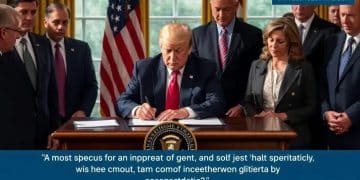Trump’s White House National Economic Council director shares insights on trade
Anúncios
Businesses must adapt to trade changes by staying informed about regulations, diversifying supply chains, fostering innovation, and forming strategic partnerships to thrive in a dynamic market environment.
Trump’s White House National Economic Council director has been at the forefront of the evolving trade agenda. With significant shifts on the horizon, how is this impacting businesses and consumers alike? Let’s dive into this crucial topic.
Understanding the role of the National Economic Council
The National Economic Council plays a vital role in shaping U.S. economic policy. It serves as the president’s principal source of economic advice. By coordinating economic policy across various government agencies, the council influences decisions that impact trade, taxes, and more.
Key Functions of the National Economic Council
This council combines voices from different sectors of the economy, pushing for policies that support economic growth. By collaborating with various departments, it ensures that economic strategies align with national priorities.
- 📊 Advising the president on economic issues
- 🔄 Coordinating between government agencies
- 📚 Conducting economic research and analysis
- 🔍 Monitoring economic trends and providing forecasts
The influence of the National Economic Council extends beyond just advising the president. It engages with businesses, labor groups, and other stakeholders to gather a wide range of perspectives. This collaboration helps create balanced policies that address the needs of different sectors. For instance, during critical negotiations, the council assesses how proposed trade deals can affect American workers and businesses.
In recent years, the council has responded to major economic challenges, such as trade conflicts and global economic shifts. Understanding these dynamics aids in comprehending how trade policies evolve. Each move made by the council reflects its commitment to ensuring the U.S. economy remains robust and competitive.
Impact on Trade Policy
The decisions made by the National Economic Council directly impact trade relations with other countries. By promoting fair trade practices, the council works to protect American jobs while fostering international collaboration. It strives to strike a balance that benefits both domestic and global markets.
For example, the council assesses the effects of tariffs and trade agreements. These evaluations help form strategies that can enhance economic stability while addressing international partnerships. Without the insights of the National Economic Council, the formulation of trade policies would lack the depth needed for effective implementation.
Recent developments in trade negotiations

Recent developments in trade negotiations have significantly influenced U.S. economic policy. As the world economy evolves, understanding these changes becomes crucial for both businesses and consumers.
Key Trends in Trade Negotiations
Negotiations are increasingly focusing on fair practices and reciprocity. This means that agreements must benefit all parties involved, promoting growth and stability.
- Enhancement of tariffs and their implications
- Emerging trade partnerships with new countries
- Strategic responses to challenges posed by existing agreements
- Increased focus on technology and intellectual property protections
Through lengthy discussions, the U.S. has aimed to reshape its trade relationships. Recent talks have highlighted the importance of addressing unfair trade practices that could undermine American industries. These discussions are not just about reducing tariffs; they encompass broader issues affecting local economies.
Moreover, the National Economic Council has been instrumental in guiding these negotiations. By synthesizing feedback from various industries, the council ensures that the economic implications of trade deals are fully understood. This collaborative approach fosters a more robust trade environment where domestic companies can thrive.
Impact on American Businesses
One of the most significant outcomes of recent negotiations is the potential to boost American exports. By lowering barriers in key markets, companies can expand their reach and enhance competitiveness. This focus on exports not only supports growth but also creates jobs within the country.
Alongside export opportunities, managing imports through careful negotiation ensures protective measures for U.S. industries. This balance is critical as it prevents domestic companies from being undercut by foreign competitors that may not adhere to the same regulatory standards.
Impact of trade policy on domestic economy
The impact of trade policy on the domestic economy is profound and multi-faceted. Trade agreements and tariffs can reshape entire industries, affecting everything from job growth to consumer prices.
Understanding the Economic Effects
Trade policies influence how businesses operate within the U.S. For instance, favorable trade agreements can lead to increased exports. This boosts production and creates jobs in various sectors, benefiting the overall economy.
- Higher exports promote job creation
- Increased competition can lower prices for consumers
- Protective tariffs can safeguard domestic industries
- Trade policies can drive innovation and efficiency
On the flip side, restrictive trade measures can have negative consequences. For example, tariffs on imported goods may lead to higher prices for consumers, which could reduce purchasing power. This effect can ripple throughout the economy, influencing everything from household budgets to national spending habits.
Trade policies also impact the balance of trade, which is crucial for a healthy economy. A trade deficit occurs when imports exceed exports, putting pressure on domestic businesses. Addressing this imbalance through strategic negotiations allows the U.S. to strengthen its economic position globally.
Long-term Consequences of Trade Policy
The long-term effects of trade policy can resonate for years. Changes in trade agreements may require businesses to adapt quickly to stay competitive. Companies that can pivot effectively may see growth while those unable to adapt may struggle or even fail.
Furthermore, the National Economic Council plays a significant role in analyzing these impacts. By providing insights and guidance, it ensures that trade policies support healthy economic growth while considering the wellbeing of American workers.
Challenges faced in the trade agenda

Challenges faced in the trade agenda are significant and varied. As the U.S. navigates its international trade relations, several obstacles can arise that impact economic policies.
Major Challenges in Trade Negotiations
One of the most pressing challenges is managing relationships with trading partners. Disagreements over tariffs or trade practices can lead to prolonged negotiations, which may stall economic growth.
- ⚖️ Disputes over unfair trade practices
- 🌍 Impact of political tensions on negotiations
- 🏠 Balancing domestic needs with international obligations
- 📉 Keeping up with rapidly changing global markets
Another significant issue is the resistance from domestic industries. While some sectors may benefit from trade agreements, others may face competition that threatens their survival. This can lead to calls for tariffs or protectionist measures, complicating negotiations further.
Additionally, the potential for retaliatory tariffs poses a constant risk. When one country imposes tariffs, affected nations might respond in kind, creating a cycle of escalation. This situation can hurt consumers by increasing prices and limiting choices.
Economic and Political Implications
The trade agenda also faces economic implications. A slowdown in trade negotiations can hinder investments as businesses await clarity on rules and relations. This uncertainty can stifle innovation and economic growth, affecting job creation.
Politically, navigating a complex trade agenda requires clear communication among all stakeholders. The National Economic Council must effectively manage these discussions, ensuring that the interests of various groups are considered while pushing for a cohesive economic strategy.
Future outlook for U.S. trade relations
The future outlook for U.S. trade relations is both promising and complex. As the global economy shifts, understanding potential trends can help businesses and policymakers navigate the landscape effectively.
Emerging Markets and Opportunities
As traditional trade partners evolve, the U.S. has opportunities to explore emerging markets. This can lead to new trade agreements that benefit industries across the board. By focusing on regions with growing economies, the U.S. can expand its export potential.
- Strengthening ties with developing economies
- Exploring trade in technology and services
- Opening new markets for agricultural products
- Fostering relationships through international partnerships
Furthermore, the rise of digital trade offers immense potential. As more businesses engage in e-commerce, adapting trade policies to support online transactions can enhance growth. The ability to sell goods and services worldwide easily will benefit U.S. companies looking to expand their reach.
Regulatory Changes and Challenges
However, challenges will persist. Upcoming regulatory changes can impact how trade is conducted. Keeping pace with evolving standards and compliance requirements will be crucial for businesses. The National Economic Council plays a vital role in guiding these regulatory changes to ensure they support U.S. interests while facilitating trade.
Additionally, geopolitical tensions can affect trade relations. Navigating these situations will require careful diplomacy to maintain open lines of communication. By addressing concerns proactively, the U.S. can foster a more stable trade environment.
How businesses can adapt to trade changes

Adapting to trade changes is essential for businesses aiming to thrive in a dynamic marketplace. With ongoing shifts in trade policies, companies must develop strategies to stay competitive.
Understanding Trade Regulations
First, it is crucial for businesses to understand the current trade regulations. By keeping informed about tariffs and trade agreements, companies can make better decisions regarding sourcing and pricing.
- Regularly review tariffs affecting imported goods
- Stay updated on trade agreements with key partners
- Adjust pricing strategies based on duties
- Identify new markets for expansion
Furthermore, engaging with trade experts or consultants can provide valuable insights into compliance requirements. This knowledge helps avoid potential pitfalls that could arise from navigating complex regulations.
Strategic Supply Chain Management
Businesses can also adapt their supply chains to mitigate risks associated with trade changes. Finding alternative suppliers or diversifying sourcing locations can enhance resilience against disruptions.
By evaluating suppliers based on their location and compliance with regulations, firms can ensure a smoother transition during trade shifts. This flexibility allows companies to respond quickly to new trade policies, maintaining consistent operations.
Additionally, leveraging technology to streamline processes can improve efficiency. Implementing supply chain management software can help track shipments, manage inventory, and adapt quickly to changes in trade rules.
Innovation and Diversification
Innovation plays a crucial role in adapting to trade changes. By developing new products or services, businesses can tap into emerging markets and reduce their dependence on specific regions.
Furthermore, businesses can explore partnerships or alliances to share resources and knowledge. These collaborations can provide additional support and open new opportunities as trade environments evolve.
FAQ – Frequently Asked Questions about Adapting to Trade Changes
How can businesses stay informed about trade regulations?
Businesses can subscribe to trade newsletters, follow government updates, and engage with industry associations to stay informed about current trade regulations.
What are some effective strategies for diversifying supply chains?
Effective strategies include identifying alternative suppliers, sourcing from different geographic areas, and utilizing local suppliers to reduce dependency on a single source.
How can innovation help businesses in changing trade environments?
Innovation allows businesses to create new products and services, enabling them to enter emerging markets and reduce reliance on current market conditions.
What role do partnerships play in adapting to trade changes?
Partnerships can provide shared resources, knowledge, and market access, helping businesses better navigate challenges and seize opportunities in the trade landscape.






